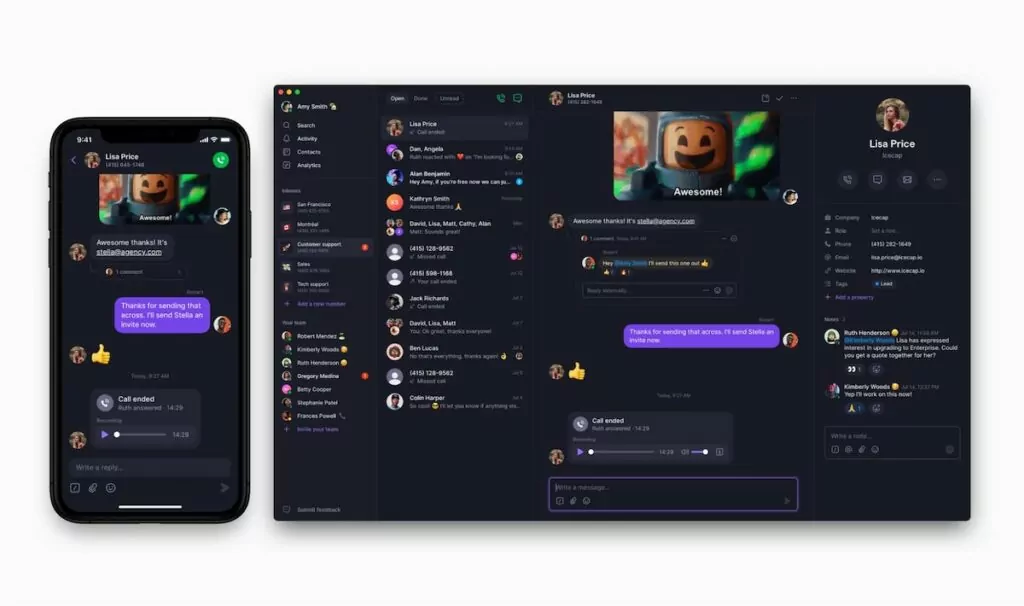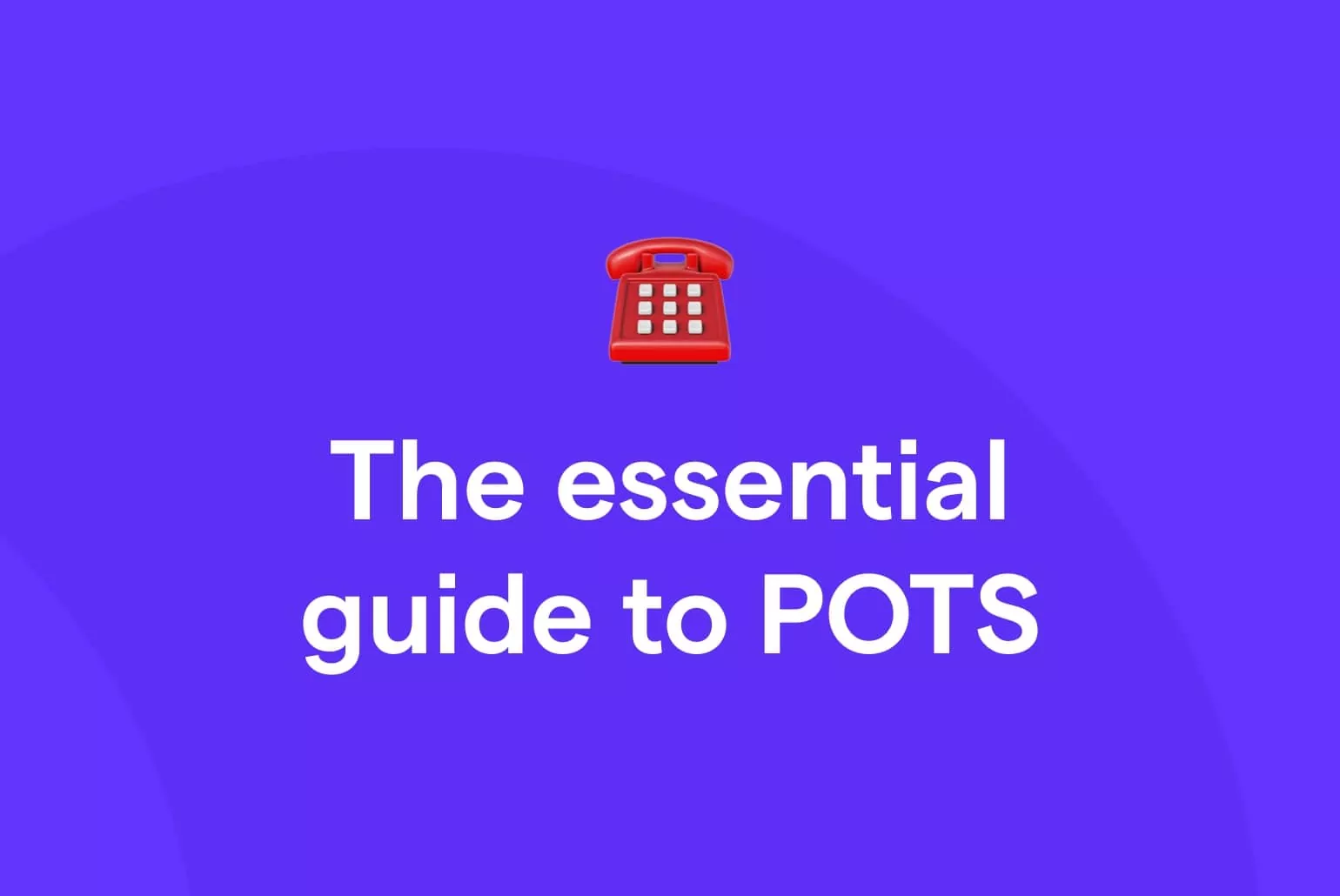Believe it or not, we didn’t always carry supercomputers around in our pockets. Smartphones and widespread internet connectivity are relatively recent innovations.
The official birthday of the internet was January 1, 1983, and the world’s first smartphone was released in 1994 by IBM. Since then, we’ve come a long way, building upon traditional phone systems to create the modern phone networks we know and love today.
But those old phone systems have been showing their age for a while now, and newer, more powerful and flexible alternatives now exist.
In this post, we’ll define POTS (plain old telephone service) and explain how it’s kept our world connected since the late 1800s. By the end, you’ll be able to make the best decision for your business phone system by choosing a modern business phone alternative to POTS lines.
What is a POTS line?
POTS is an acronym used to describe the analog telephone service the US has used for over 100 years. Better known as “plain old telephone service,” the system transmits signals via copper wires.
You may have also heard it referred to as the public switched telephone network (PSTN), which is a fancier term for the same system.
POTS is based on Alexander Graham Bell’s phone system, the first in the world of its kind. It makes use of copper twisted pair wires to connect homes and businesses to central control rooms. POTS used to stand for “post office telephone service,” because post office operators were the ones who connected callers from a switchboard.
After making the transition away from operators, the switching process was automated for calls made over POTS lines. The newer, centralized system was better adapted to handling high call volumes and managing calls across long distances.
But it was still lacking in features. At first, there was no way to block numbers, and call forwarding was still just an idea.
As technology advanced, features like call waiting, voicemail, and caller ID were integrated into the POTS system. Modems and fax machines also used POTS lines to convey digital information. This analog telephone system is still the basis for most of our modern telecommunications.
How do POTS lines work?
When you make a call through POTS, the system establishes a connection between point A (where you are) and point B (where your intended call recipient is). Because the POTS lines system is completely analog, it uses copper wires to connect between the two locations.
Depending on where you’re calling from, your call may need to be routed through several central offices to reach its final destination.
Once you’ve placed your call, the audio is converted from sound waves into electrical analog signals. These signals are carried by the copper wires to the receiver’s end. Then, they’re changed back into sound waves so that the receiver can understand you.
One of the downsides of copper lines is that they can create noise interference. The signals they transmit also grow weaker with distance, meaning that amplification may be necessary to deliver the signals from caller to receiver.
What is the best alternative to POTS lines?
The best alternative to POTS is VoIP. But it’s not the only alternative, so let’s explore some other options and then look at what VoIP wins easily.
While POTS lines have been used for decades to manage call routing for both personal and business purposes, things are changing fast. The technology is becoming outdated, and maintenance costs are soaring. That leaves business and personal users seeking more modern, convenient solutions to traditional plain old telephone service.
One alternative is an integrated services digital network (ISDN), which transmits digital signals through analog lines. Digital subscriber lines (DSLs) are another option. DSL makes use of existing copper lines and multiple transmission frequencies to simultaneously send analog voice audio and digital information.
However, a DSL connection may require a filter to prevent digital “leaks,” and both solutions need physical wires connecting them to service.
Enter Voice over Internet Protocol (VoIP) phone systems. Rather than converting sound waves into electrical analog signals like POTS lines do, your VoIP works by converting sound waves into digital signals. These signals are transmitted via the internet rather than traditional telephone lines.
Hands-down the best alternative to POTS lines, VoIP systems offer expanded user features, along with flexibility that simply wasn’t possible with analog lines. VoIP allows you to place and receive calls from any internet-enabled device. You can also tap into an LTE data connection if you experience power outages or poor connections.
Why choose a VoIP service provider?
Using a landline phone system supported by POTS probably isn’t the best business decision you can make in the 21st century. VoIP technology trumps POTS lines for several reasons.
Cost-effectiveness
The rising costs of POTS line maintenance and service means that the technology will soon become cost prohibitive. The POTS pricing model is also outdated, with users having to pay extra for setup and each additional feature. In the US, major telecom companies are lobbying the FCC to eliminate legacy POTS systems, which have fewer subscribers with each passing year.
Telecom giant AT&T, for instance, has raised phone prices by 153% over the past decade. All the while, service quality has deteriorated, as has customer satisfaction.
Better call quality
Because VoIP lines make use of your broadband internet connection rather than copper wires, you won’t have to worry about a decline in call quality. If you’re switching from a POTS legacy system, you should expect clearer audio, as long as your internet service is up to the task (you can verify your bandwidth strength with a simple VoIP speed test).
Expanded features
Apart from better call quality, you’ll enjoy access to features that simply aren’t compatible with POTS lines, like Do Not Disturb mode, texting, and shared phone numbers. You can also forward calls to and from any device, minimizing missed calls and simplifying your life. Some VoIP providers even offer third-party integrations, so you can connect your phone system with business operations and customer relationship management (CRM) software.
Easy setup and maintenance
Every business needs an efficient system to communicate internally and with clients. POTS service can be difficult to install and maintain, since it requires physical wires running to your place of business. That also makes it incompatible with remote work, which is growing in popularity.
A business VoIP phone service like OpenPhone is easy to set up, just requiring users to fill out a simple signup form and (optionally) download an app. OpenPhone has an intuitive user interface that allows you to add team members, accept calls, and program settings with the click of a button. When making the switch to VoIP, you’re even able to port your existing phone number over to your new system for a seamless transition.
Plus, who wants to manage server rooms and complex hardware? With OpenPhone, you can access your business phone 24/7 via our app from your cell phone, tablet, desktop, or web browser. Since OpenPhone is hosted in the cloud and delivered using a Software as a Service model, all maintenance is handled by our team. All you have to do is occasionally download an app update.
Increased flexibility
Not all offices make use of handsets and wired phone lines. Today, the expansion of remote work and international business means that you need a business phone system that offers flexibility. A VoIP service like OpenPhone allows you to conduct business from anywhere, without being shackled to your desk.
With a modern unified communications system, you can say goodbye to the restrictions of desk phones and hello to the superior capabilities of VoIP telephony.
Set up your VoIP service today with OpenPhone

Traditional landlines are now considered a thing of the past, and VoIP phone systems are here to stay. That’s why businesses everywhere are trading in their outdated POTS lines for a VoIP solution with stand-out customer service and all the calling features you need to run your business. From call recording to interactive voice response, all of OpenPhone’s features are at your fingertips for one flat price.
Sign up for your free OpenPhone trial today to explore all that our system has to offer.
